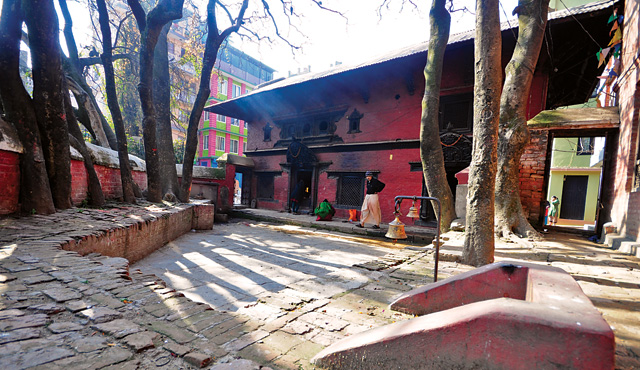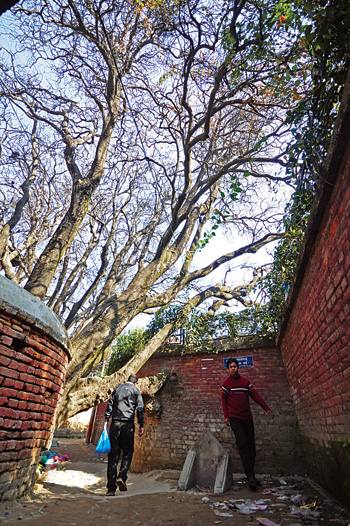For 4000 years and more, a holy fire has burned continuously at the Agnishala Temple in Patan. If you want to set your graha dasha (planetary configuration) right, have a hom (fire rite) performed here.

July 4 was an important day for the Rajopadhayas of Patan. It was when they celebrated the third janku of the Agnihotri at the Agnishala Temple. Now, all this calls for some explanation.
The Agnihotri is the senior-most priest of the famous fire shrine, the Agnishala Temple, located at the end of a lane opposite Kumaripati (where Living Goddess Kumari sits during important festivals) on Kumaripati Road. Janku is a Newari ceremony to celebrate a person reaching the age of 77 years, seven months, and seven days. After that, successive jankus are held after certain periods. The current Agnihotri is 89-year-old Bripendra Raj Rajopadhaya of Pimbahal. Now, what about the Rajopadhayas? Well, most of the important shrines in Kathmandu Valley have priests from this clan, including the ones at Agnishala Temple. They are mostly to be found around five or six specific localities of Patan.

Let’s now talk about the Agnishala Temple, the focal point. Bhaskar Rajopadhaya, one of the priests, says,“This temple is believed to be about 4000 years old. A fire has been kept burning here as far back as I know. People come to set right present and anticipated misfortunes arising from unfavorable graha dashas. We perform a hom (ritual in which offerings are made to the holy fire) for them.”
The temple has four kundas (fire altars): Vishnu Kunda, Brahma Kunda, Shiva Kunda, Surya Kunda, and Savya Kunda. There’s a fire burning on the Vishnu Kunda at all times, while fires are set alight on all kundas during the nitya puja (daily worship) in the morning and evening. The temple is open from 7am till noon, and for an hour every evening. “People just have to bring some ghee, teel (black sesame seeds), and jaun (barley). We do the rest,” says Om Kantha Rajopadhaya, another priest. According to Bhusan Nath Sharma, the general secretary of the temple management committee, this is probably the only fire temple anywhere with five kundas. He says, “All others have only one kunda, as far as I know.”
 Any occasions when the temple is especially visited? “The full moon days of Magh (Jan/Feb) and Baisakh (April/May) are important. The former is Maghe Sankranti (a festival to welcome spring) while the latter is Buddha Jayanti. The first day of Kartik (mid October) marks the temple’s anniversary.”
Any occasions when the temple is especially visited? “The full moon days of Magh (Jan/Feb) and Baisakh (April/May) are important. The former is Maghe Sankranti (a festival to welcome spring) while the latter is Buddha Jayanti. The first day of Kartik (mid October) marks the temple’s anniversary.”
I want to know more about the Agnihotri. “The eldest among the Rajopadhayas is chosen as the Agnihotri,” explains Bhasker. “He has to be married and his spouse should be alive. Previously, the Agnihotri used to perform the pujas himself, but now five or six younger Rajopdhaya men do the needful.” I ask him about health hazards due to the smoke, and he replies, “Earlier, there was really too much smoke inside, but later, arrangements were made to have some ventilation. Anyway, the things burned here are non-polluting.”
How many kinds of hom are done? Om Kantha answers, “Quite a few. Two examples: Jogini Graha Pooja (to appease nine goddesses) and Nava Graha Pooja (to appease the nine planets). Hom is also done to offset negative effects of different planets, Sani (Saturn) being an especially important one.” People also visit to have a hom performed during birthdays.
What about the expenses? “Ten to twenty rupees is the usual cost,” replies Om Kantha. “Some homs may go up to about 300 rupees.” Well! In this age of crass commercialism in all things public, including education, healthcare, and also, yes, religion, isn’t it great to know that you can have spiritual relief for such small amounts? That, too, at such a famous shrine as the Agnishala Temple!
Barun Brikshya
On the premises of the Agnishala are some large trees, a couple of which can be seen bent over due to their own weight. “These are Barun Brikhyas,” says Pramod Sharma, the chairman of the temple management committee. “You won’t find such a tree anywhere else in Nepal except in Gu:bahal of Patan, where one of our own planted a sapling some time ago.” Scientifically named Crataeva religiosa, this species can be found in Australia, J apan, South East Asia, and some South Pacific islands. Local myth has it that any place having this tree never lacks for water, thus the name Barun Brikshya (Barun: god of water; brikshya: tree). The tree is also known as ‘sacred garlic pear tree’. Apparently, in ancient times, sages took one such fruit before going into deep meditation, and it would sustain them for a whole month.










